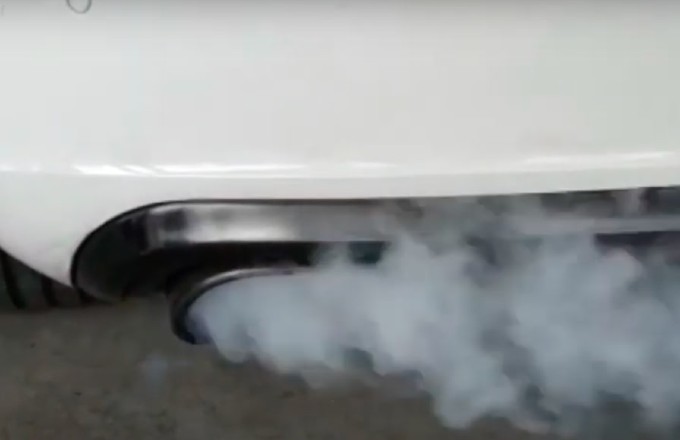As drivers, we often have a thorough understanding of our cars. Because of this, the majority of drivers are able to spot little variations in their car’s performance from day to day. Because we typically consider the symptoms associated with these problems to be {new¨ or {strange,¨ we are quick to identify any problems that occur.
This usually happens when someone observes any kind of white smoke coming the exhaust of their car. Many find this to be a serious cause for concern since it’s an unusual sight that makes them wonder what might have caused their white smoke from exhaust to change so quickly.
White smoke from exhaust with a white appearance is one of the most prevalent complaints of this kind. This kind of smoke is frequently rather dense in nature, making it visible to any onlooker around. There is plenty to be concerned about because this smoke usually appears most noticeably during startup or acceleration.
Continue reading to find out what might be causing the white smoke from exhaust and how to deal with it if it happens again.
How Should the Look of Exhaust Emissions Be?
In an ideal world, a car’s white smoke from exhaust should always be reasonably visible when the engine is running. This indicates a high combustion efficiency resulting from a reasonably healthy engine.
To put it simply, an engine involves introducing fuel or air into each cylinder precisely measuring it. After this air/fuel mixture is burned to a high degree of completion, not many hazardous hydrocarbons, oxides, or dioxides are left behind.
Conversely, a car’s exhaust ought to be hardly noticeable, if it’s noticeable at all.
An overall absence of white smoke from exhaust suggests that, in optimal conditions, nothing is getting into the combustion chambers of a car. The two most famous examples of this are coolant and oil, neither of which ought to be present in significant amounts during combustion.
It is noteworthy, therefore, to emphasise that it is rather typical for a car’s exhaust to exhibit trace amounts of light grey or white smoke from exhaust immediately after starting up, or occasionally during extremely cold weather.
This happens when minute amounts of water heat up in the white smoke from exhaust when accelerating of a car. The condensation process is what brought this water into existence naturally.
However, these minute amounts of water ought to be removed quite rapidly and ought to result in white smoke from exhaust when accelerating that doesn’t seem particularly dense. This kind of exhaust smoke, or more accurately, steam, ought to evaporate quickly following a car exhaust.
If this white smoke from exhaust when accelerating doesn’t go away right away or seems to be getting heavier over time, there may be another underlying problem at hand. In this instance, additional diagnosis will be necessary to identify the problem.
Reasons Your Exhaust Is the Source of White Smoke
Although white smoke from exhaust when accelerating is nearly always a sign of coolant or water contamination in one or more cylinders, there are situations when other factors can also be at play.
Some of the most frequent reasons behind white smoke coming from exhaust are listed below.
Blown Head Gasket
Often, a burst head gasket is the cause of thick, white smoke coming from exhaust. In addition to sealing the space between an engine’s block and cylinder heads, this crucial gasket stops coolant, oil, and compression loss.
White smoke is a result of coolant seeping into one or more engine cylinders where it burns due to a failed head gasket.
Compromised Intake Manifold Gasket
Thick, white smoke coming from exhaust may occasionally truly be the result of a leaky intake manifold gasket. Naturally, this is only valid if water jackets are used on the intake manifold of your engine.
In these situations, an engine’s blown head gasket can cause many of the same symptoms as an intake gasket failure, allowing coolant to enter one or more of the engine’s cylinders.
Cracked/Warped Cylinder Head
Thick, white smoke coming from exhaust may potentially be the result of a damaged cylinder head.
A broken cylinder head can cause coolant to seep into one or more combustion chambers, where it burns and produces white smoke from exhaust on startup then goes away, much like what happens with a blown head gasket. The only way to solve this issue is to replace the damaged cylinder head.
Cracked Engine Block
Even though it happens less frequently, an engine’s block might crack, letting coolant enter one or more cylinders. Sadly, this kind of failure is regarded as catastrophic in nature and usually means the engine in question is done for good.
It is now up to the driver to decide if it is worth the cost and inconvenience to replace the engine in their car.
Is Driving Safely Still Permitted?
Although operating a car that is producing white smoke from exhaust on startup then goes away may not always be terribly dangerous, it is definitely not recommended. As was already said, the presence of thick, white smoke coming from a white smoke from exhaust on startup then goes away suggests that coolant is being burned, at least partially. This offers various issues in addition to the possibility of overheating.
There is a chance of hydrolock anytime coolant gets into one or more combustion chambers.
When there is non-compressible water inside the combustion chamber, a piston becomes stuck and cannot rise within its cylinder bore. This phenomenon is known as “hydrolock.” Engine damage is often severe and irreparable as a result of this problem.
In any case, it is imperative to identify and address the underlying cause of the white smoke from exhaust on startup then goes away as quickly as possible. By doing this, you’ll minimise the possibility of secondary engine damage and stop the problem from getting worse.


